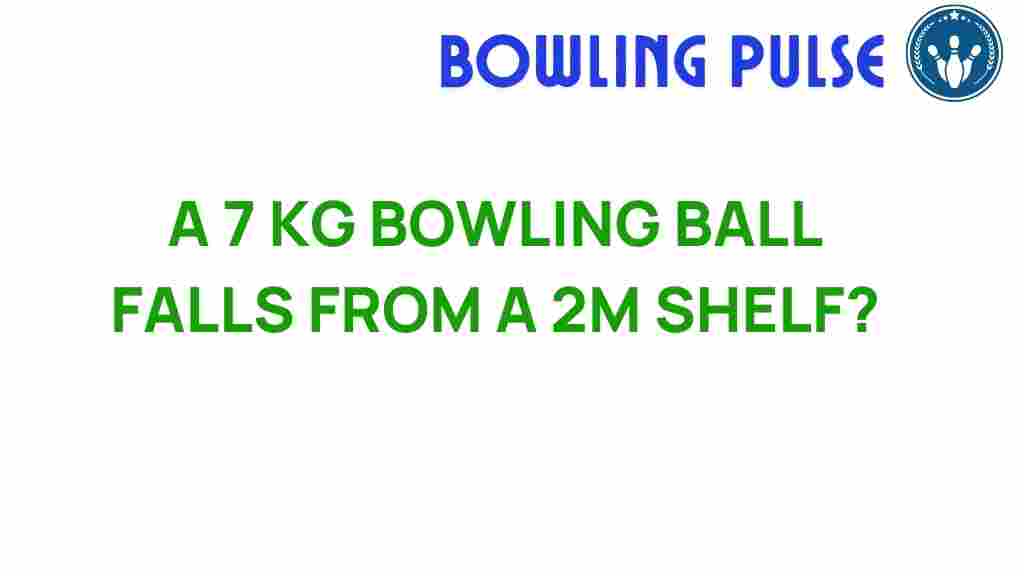The Physics Behind a 7 KG Bowling Ball’s Fall
Understanding the physics behind a bowling ball’s fall can enhance your appreciation of the sport and improve your bowling techniques. When a 7 kg bowling ball falls, several physical principles come into play, including gravity, momentum, and impact dynamics. In this article, we will explore these concepts in detail, focusing on what happens when a bowling ball falls from a shelf and the implications for safety and sports science.
The Role of Gravity
Gravity is the force that pulls objects towards the Earth. For a 7 kg bowling ball, the gravitational force can be calculated using the formula:
Force (F) = mass (m) × acceleration due to gravity (g)
In most cases, we consider the acceleration due to gravity (g) to be approximately 9.81 m/s². Therefore, the force exerted by the bowling ball due to gravity is:
F = 7 kg × 9.81 m/s² = 68.67 N
This force is what causes the bowling ball to accelerate towards the ground when it falls from a shelf.
Understanding Free Fall
When a bowling ball falls freely, it accelerates downwards at 9.81 m/s². This acceleration continues until the ball makes contact with the ground or another surface. During free fall, the bowling ball experiences:
- Increased velocity: The longer the ball falls, the faster it moves.
- Potential energy conversion: As the ball falls, its potential energy (due to its height) converts into kinetic energy (due to its motion).
Impact Dynamics
When the bowling ball strikes the ground, the impact is influenced by several factors:
- Velocity at impact: The faster the ball is moving when it hits the ground, the greater the force of impact.
- Surface type: The material of the surface affects how the energy is absorbed. A hard surface like concrete will result in a more forceful impact compared to a softer surface like grass.
- Angle of impact: The angle at which the ball hits the ground can also influence the outcome, affecting the direction of the ball’s subsequent movement.
Momentum and Bowling Balls
Momentum is defined as the product of an object’s mass and its velocity. For the 7 kg bowling ball, momentum (p) can be calculated using the formula:
p = m × v
Where:
- m = mass of the bowling ball (7 kg)
- v = velocity of the bowling ball at the moment of impact
As the bowling ball falls and accelerates, it gains momentum. This momentum is crucial in understanding how the ball behaves when it collides with the ground or other objects, such as pins in a bowling alley.
What Happens After the Bowling Ball Falls?
Upon impact, several scenarios can occur:
- Rebound: The ball may bounce back depending on the surface and its velocity at impact.
- Rolling: If the ball hits a surface at an angle, it may roll instead of bouncing.
- Energy dissipation: Some of the energy from the fall is dissipated as sound and heat during the impact.
Safety Considerations
Understanding the physics of a falling bowling ball is not just academic; it has practical implications for safety. Here are some safety tips:
- Proper shelving: Always ensure that bowling balls are stored on stable shelves to prevent accidental falls.
- Bowling ball weights: Be aware of the weight of the bowling ball you are handling. A 7 kg ball can cause injury if it falls on a person.
- Flooring: Ensure that the bowling area has appropriate flooring that can absorb some impact and prevent slipping.
Bowling Techniques to Minimize Risk
When handling bowling balls, proper techniques can help minimize the risk of accidents:
- Use both hands: Always lift the bowling ball with both hands to maintain control.
- Stay low: Bend your knees when lifting or placing the bowling ball to avoid straining your back.
- Practice proper release: During a throw, practice a smooth release to prevent the ball from dropping suddenly.
Common Troubleshooting Tips
When dealing with falling bowling balls and their effects, consider these troubleshooting tips:
- Check your storage: Ensure that bowling balls are stored securely to prevent them from falling.
- Monitor your technique: If you notice frequent accidents, evaluate your handling techniques and adjust accordingly.
- Inspect equipment: Regularly check the condition of bowling balls and shelves to ensure they are safe for use.
Conclusion
The physics behind a 7 kg bowling ball’s fall is a fascinating interplay of gravity, momentum, and impact dynamics. Understanding these principles not only enhances your knowledge of sports science but also helps in ensuring safety while enjoying the game of bowling. By applying proper techniques and safety measures, you can enjoy the thrill of bowling while minimizing risks associated with falling bowling balls.
For more insights on bowling techniques and safety, feel free to check out our bowling safety guide. Additionally, you can explore more about the physics of sports at Physics of Sports.
This article is in the category Techniques and created by BowlingPulse Team
